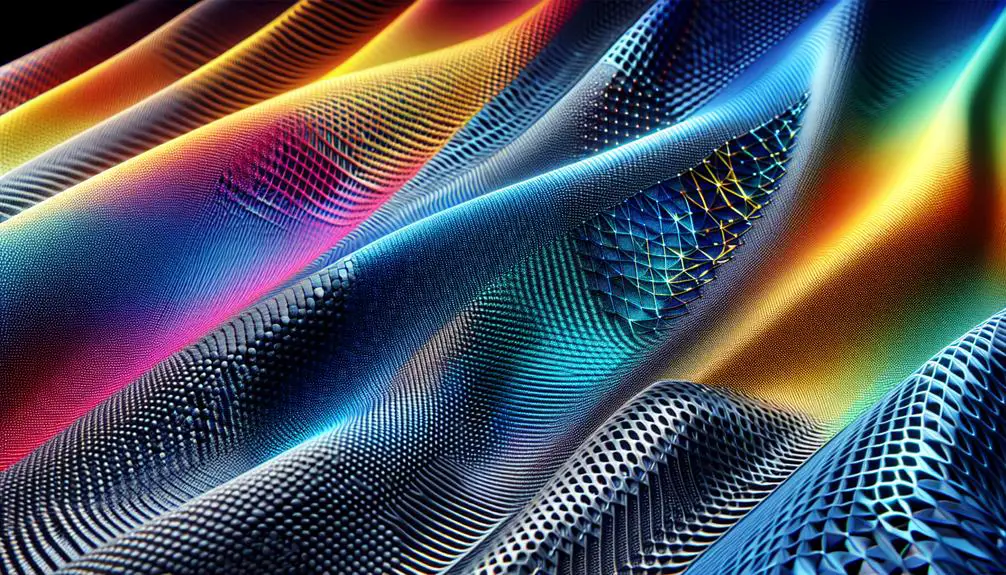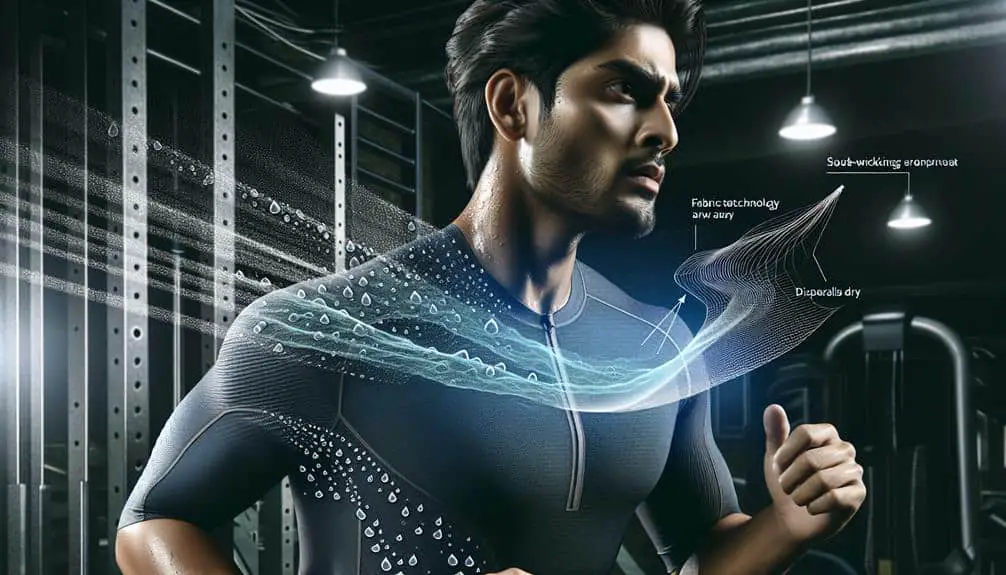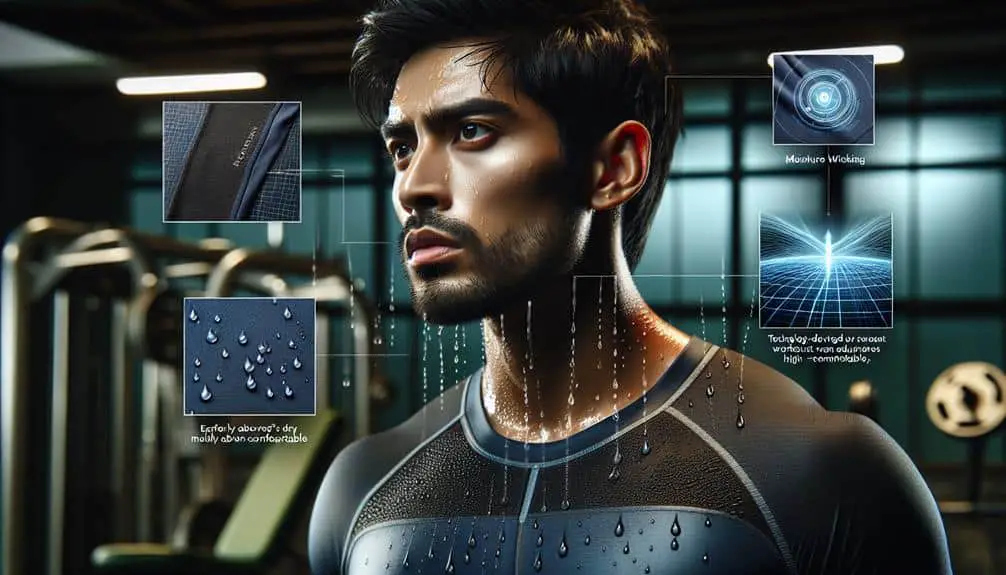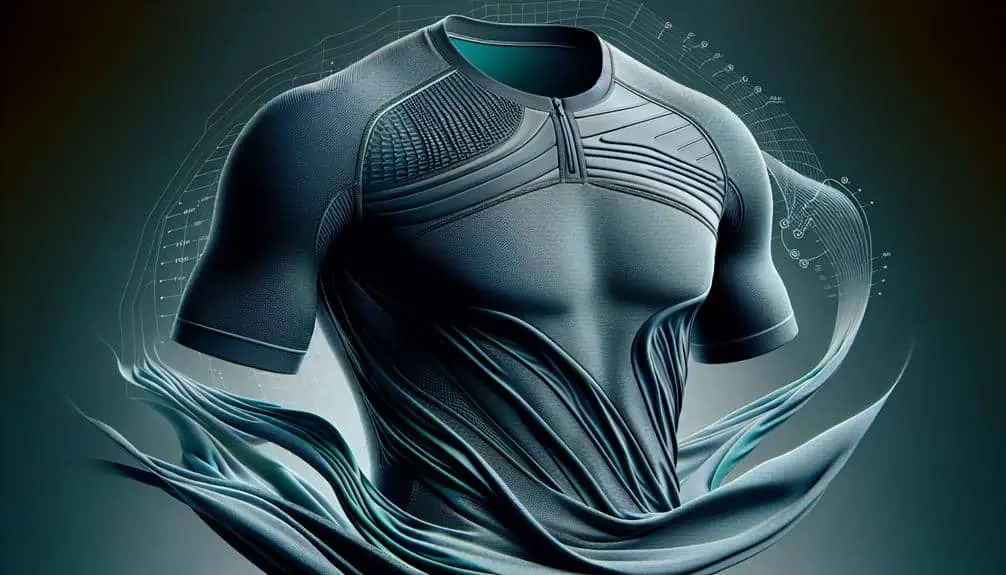To optimize moisture-wicking in fabrics, choose synthetic fibers like polyester and nylon. These materials efficiently move sweat away from your skin. Seek specialized weaves or knits creating channels that aid in sweat removal. For enhanced performance, prioritize fabric breathability to regulate body temperature and reduce moisture. Understanding fabric weaves impact moisture-wicking capabilities to a large extent. Look for fabrics with moisture-wicking treatments and antimicrobial properties for added benefits. Factors like durability, sustainability, and innovative technologies further enhance moisture-wicking potential. Unravel the intricacies of fabric technology secrets to elevate your comfort and performance effortlessly.
Key Points
- Synthetic fibers like polyester and nylon excel in moisture-wicking due to their efficient sweat control.
- Microfiber technology with ultra-fine fibers rapidly draws moisture away from the skin for enhanced comfort.
- Fabric breathability crucial for regulating body temperature and optimizing athletic performance.
- Innovative enhancements like moisture-wicking treatments and antimicrobial properties elevate fabric performance.
- Sustainability options include recycled polyester, bamboo, hemp, organic cotton, and Tencel for eco-friendly choices.
Understanding Moisture-Wicking Fabric
To comprehend moisture-wicking fabric, you must understand its unique ability to transport sweat away from your skin efficiently. Fabric construction plays an important role in moisture management. Performance wear designed with moisture-wicking properties typically consists of synthetic fibers like polyester or nylon woven in a way that encourages moisture to move through the material. The construction involves specialized weaves or knits that create gaps or channels in the fabric, allowing sweat to be pulled away from your body to the outer surface where it can evaporate more easily. This process is essential for effective sweat control during physical activities.
Moisture-wicking fabrics excel in keeping you dry and comfortable by managing sweat effectively. Unlike traditional materials, these advanced textiles prioritize moisture transfer, ensuring that you stay cool even during intense workouts. By understanding the intricacies of fabric technology and moisture management, you can make informed decisions when selecting performance wear for your activities.
Synthetic Vs. Natural Fibers
Synthetic fibers such as polyester and nylon offer superior moisture-wicking properties compared to natural fibers in performance wear fabrics. When it comes to fiber comparison for moisture management and fabric choices, synthetics excel due to their hydrophobic nature, which repels moisture and allows it to evaporate quickly. Polyester, for instance, is known for its excellent moisture-wicking capabilities, making it a popular choice for activewear. Nylon, on the other hand, is durable and dries quickly, further enhancing its moisture-wicking performance.
In contrast, natural fibers like cotton tend to absorb moisture rather than repel it. Cotton can retain sweat, leading to dampness and discomfort during physical activities. While natural fibers have their place in clothing, especially for everyday wear, they're less ideal for performance wear where moisture-wicking is essential. Understanding the performance benefits of synthetic versus natural fibers is essential for selecting the most suitable fabric for your moisture-wicking needs.
Microfiber Technology Explained
In exploring fabric technology secrets for moisture-wicking, a pivotal aspect to understand is Microfiber Technology Explained. Microfibers are ultra-fine synthetic fibers, typically with a diameter of less than 10 micrometers. These fibers are known for their exceptional moisture-wicking capabilities, making them a popular choice in activewear and performance fabrics.
One of the key benefits of microfiber technology is its ability to quickly draw moisture away from the skin, keeping you dry and comfortable during physical activity. The small diameter of microfibers also allows for a larger surface area, enhancing their moisture-wicking properties.
However, one drawback of microfiber fabrics is their tendency to hold onto odors if not properly cared for. It's essential to follow the manufacturer's care instructions to maintain the fabric's performance and longevity.
Advancements in moisture-wicking technology have led to the development of microfiber blends that offer improved breathability and durability. These innovations continue to push the boundaries of fabric technology, providing athletes and outdoor enthusiasts with high-performance apparel for their active lifestyles.
Breathability in Performance Fabrics
When it comes to performance fabrics, understanding fabric breathability is essential to optimize comfort during physical activity.
Fabric breathability benefits include regulating body temperature, reducing moisture buildup, and enhancing overall comfort.
Technology for air flow and moisture-wicking properties plays a significant role in ensuring that the fabric can efficiently transfer sweat away from the skin, allowing for improved ventilation and a drier feel.
Fabric Breathability Benefits
Fabric breathability benefits greatly impact the performance and comfort of athletes by enabling efficient moisture transfer and heat regulation during physical activities. When moisture-wicking innovation combines with cooling technology in performance fabrics, it enhances comfort and performance.
The capability of fabrics to breathe guarantees that sweat is drawn away from the body, keeping you dry and cool. This process helps in preventing discomfort and chafing during intense workouts. By promoting airflow and allowing heat to escape, breathable fabrics aid in maintaining a consistent body temperature.
Additionally, fabric breathability benefits prolong the life of the garment by reducing the chances of odor buildup and bacterial growth. Choosing fabrics with superior breathability is crucial for optimizing your athletic performance and overall comfort.
Technology for Air Flow
Utilizing advanced engineering techniques, performance fabrics incorporate specialized technologies to enhance air flow and breathability, essential for optimizing athletic performance and ensuring comfort during physical activities.
- Microventilation Systems: Precision-engineered micro-openings enhance air circulation within the fabric.
- Moisture-Wicking Mesh Panels: Strategically placed mesh panels facilitate moisture transfer and enhance breathability.
- Aerodynamic Weave Patterns: Innovative weaving techniques create channels for improved air flow.
- Hydrophobic Coatings: Water-repellent coatings on fibers prevent moisture buildup, enhancing air flow.
- Cooling Gel Inserts: Integrated gel inserts provide localized cooling, aiding in temperature regulation and moisture management.
Moisture-Wicking Properties Importance
Improving moisture-wicking properties in performance fabrics is vital for maintaining ideal breathability during physical activities. When moisture is efficiently drawn away from your skin, it evaporates more quickly, preventing the buildup of sweat that can lead to discomfort and potential chafing.
This process not only enhances your overall comfort but also plays an essential role in skin health by reducing the risk of irritation and rashes. Additionally, by keeping you dry and cool, moisture-wicking fabrics contribute to performance enhancement during workouts or sports activities.
The ability of these fabrics to regulate temperature and moisture levels can boost your endurance and focus, allowing you to push your limits without being hindered by sweat-soaked clothing.
The Role of Fabric Weaves
Examining the intricate patterns and structures of fabric weaves reveals significant insights into their impact on moisture-wicking capabilities. The weave of a fabric plays an essential role in determining how well it can transport moisture away from your skin. Here are five key points to ponder:
- Fabric breathability techniques: The weave of a fabric can affect how well air can circulate through it, aiding in moisture evaporation.
- Weave pattern innovations: New weave patterns are continuously being developed to enhance moisture-wicking properties and overall comfort.
- Interlacing methods: Different ways of interlacing yarns, such as plain, twill, or satin weaves, can impact how effectively moisture is pulled away from the body.
- Microscopic analysis: Examining fabrics at a microscopic level can reveal how the weave structure influences moisture movement within the material.
- Hydrophilic vs. hydrophobic weaves: Understanding whether a fabric weave is water-attracting (hydrophilic) or water-repelling (hydrophobic) is essential in predicting its moisture-wicking performance.
Benefits of Moisture-Wicking Treatments
Enhancing fabric performance through moisture-wicking treatments involves applying specialized finishes or coatings that optimize moisture management capabilities. These treatments offer a range of performance benefits that greatly enhance the comfort technology of the fabric.
By actively wicking moisture away from the skin to the outer surface of the fabric, these treatments accelerate evaporation, keeping you dry and comfortable during physical activities.
One of the key performance benefits of moisture-wicking treatments is their ability to regulate body temperature. By efficiently moving sweat away from your body, these treatments help prevent overheating or chilling, keeping you at an ideal temperature. Additionally, moisture-wicking treatments reduce the likelihood of chafing and irritation by minimizing the wetness next to your skin.
Antimicrobial Properties for Odor Control
When it comes to odor control in fabrics, antimicrobial properties play an essential role. These properties target and eliminate odor-causing bacteria, ensuring long-lasting freshness.
Odor-Eliminating Technology Benefits
Experience the cutting-edge odor-eliminating benefits of fabric technology through its potent antimicrobial properties crafted for efficient odor control. This innovative approach guarantees that your activewear stays fresh and odor-free even during vigorous workouts.
Immerse yourself in the realm of odor-eliminating technology and uncover its remarkable advantages:
- Utilizes antimicrobial agents to combat odor-causing bacteria.
- Prevents the proliferation of microbes that flourish in sweat.
- Preserves freshness by neutralizing odors at the origin.
- Prolongs the lifespan of your garments by reducing bacterial buildup.
- Improves overall comfort by keeping unpleasant odors at bay.
Embrace the potency of odor-eliminating fabric technology for a top-notch and enduring freshness experience.
Long-Lasting Freshness Feature
Immerse yourself in the world of fabric technology's long-lasting freshness feature, harnessing potent antimicrobial properties for superior odor control.
Freshness technology is at the forefront of ensuring long-lasting comfort in clothing. By integrating antimicrobial agents into the fabric fibers, unpleasant odors are effectively neutralized, providing you with a garment that stays fresh wear after wear.
These antimicrobial properties work by inhibiting the growth of odor-causing bacteria, thereby maintaining a clean and odor-free environment within the fabric. This advanced technology not only enhances the longevity of your clothing but also contributes to your overall comfort and confidence throughout the day.
Say goodbye to worries about unwanted odors and embrace the benefits of long-lasting freshness technology for a superior wearing experience.
Durability and Longevity Factors
To enhance the durability and longevity of moisture-wicking fabrics, selecting high-quality fibers and employing proper care techniques are essential factors to keep in mind. When it comes to ensuring your moisture-wicking garments stand the test of time, attention to detail is key. Here are some important factors to take into account:
- Fabric Composition: Opt for fabrics with a high synthetic fiber content, such as polyester or nylon blends, known for their durability and resistance to wear and tear.
- Seam Construction: Look for garments with reinforced seams or flatlock stitching, as these can prevent fraying and enhance overall durability.
- Avoid Harsh Chemicals: Refrain from using bleach or fabric softeners, as these can break down the fibers in moisture-wicking fabrics over time.
- Proper Washing Techniques: Wash your moisture-wicking garments in cold water on a gentle cycle to prevent damage and maintain fabric integrity.
- Air Drying: Instead of using a dryer, air dry your moisture-wicking clothing to prevent excessive heat exposure, which can degrade the fabric's moisture-wicking properties.
Sustainability in Moisture-Wicking Fabrics
When considering sustainability in moisture-wicking fabrics, it's vital to focus on eco-friendly materials and the impact of production methods.
Evaluating the lifecycle of these fabrics, from raw material sourcing to manufacturing processes, is essential in determining their environmental impact.
Eco-Friendly Moisture-Wicking Materials
Utilizing sustainable practices in the development of moisture-wicking fabrics has become imperative in reducing the environmental impact of the textile industry. When it comes to eco-friendly moisture-wicking materials, consider the following:
- Recycled Polyester: Utilizing post-consumer plastic bottles to create polyester fibers.
- Bamboo: Known for its natural moisture-wicking and antibacterial properties.
- Hemp: Sustainable and naturally resistant to mold and UV light.
- Organic Cotton: Grown without pesticides or synthetic fertilizers, reducing environmental impact.
- Tencel: Made from sustainably sourced wood pulp, offering excellent moisture-wicking capabilities.
These eco-friendly alternatives not only enhance performance but also contribute to a more sustainable future for the textile industry.
Impact of Production Methods
In exploring the sustainability of moisture-wicking fabrics, the methods employed in production play a pivotal role in minimizing environmental impact and promoting eco-conscious practices. Production efficiency is essential in reducing waste and energy consumption, contributing to sustainability.
Implementing eco-friendly practices such as using recycled materials, reducing water usage, and optimizing manufacturing processes can greatly decrease the environmental impact of producing moisture-wicking fabrics. Sustainable production methods not only benefit the environment but also enhance cost-effectiveness in the long run by minimizing resource depletion and waste disposal expenses.
Innovations in Moisture-Wicking Textiles
Developing cutting-edge moisture-wicking textiles involves integrating advanced materials and intricate engineering techniques to enhance fabric performance. In the domain of textile innovations, several breakthroughs have revolutionized the way moisture-wicking fabrics function.
Here are five key advancements driving the evolution of moisture-wicking textiles:
- Nanotechnology: Utilizing nano-sized particles to enhance fabric properties and improve moisture-wicking capabilities.
- Micro-ventilation Systems: Integrating micro-ventilation systems within the fabric structure to enhance breathability and moisture transfer.
- Hybrid Fiber Blends: Combining different fibers like polyester, nylon, and spandex to create fabrics with superior moisture-wicking properties.
- 3D Knitting Technology: Employing 3D knitting techniques to create seamless garments that optimize moisture-wicking performance.
- Moisture Absorbing Coatings: Applying specialized coatings to the fabric surface to enhance moisture absorption and quick drying capabilities.
These innovations highlight the constant evolution and refinement in moisture-wicking textiles, pushing the boundaries of performance and comfort for active individuals.
Frequently Asked Questions
How Does Moisture-Wicking Fabric Technology Differ for Different Types of Physical Activities?
When engaging in various physical activities, moisture-wicking fabric technology adapts to your needs. Different activities demand specific benefits. For instance, running requires superior sweat management compared to weightlifting. Fabric technology plays an essential role in performance enhancement.
Are There Any Specific Care Instructions for Maintaining the Moisture-Wicking Properties of Fabric Over Time?
To maintain the moisture-wicking properties of your fabric over time, follow specific washing instructions. Proper fabric care is essential for longevity and performance maintenance. Use mild detergents, avoid fabric softeners, and air dry for best results.
Can Moisture-Wicking Fabrics Be Used in Extreme Weather Conditions, Such as Very Hot or Very Cold Environments?
In extreme conditions, moisture-wicking fabrics shine. Their durability guarantees performance in very hot or cold environments. Stay comfortable and dry with these advanced textiles crafted to regulate your body temperature efficiently and effectively.
Are There Any Potential Allergic Reactions or Skin Irritations Associated With Wearing Moisture-Wicking Fabrics for Extended Periods?
Potential allergies or skin irritation from prolonged wear of moisture-wicking fabrics are rare. Comfort and breathability are prioritized in fabric design. Approximately 5% of users may experience minor reactions. Regular washing and choosing quality fabrics can minimize these issues.
How Do Moisture-Wicking Fabrics Compare in Terms of Cost and Value Compared to Traditional Fabrics?
When comparing moisture-wicking fabrics to traditional ones, consider the upfront cost versus long-term benefits. While moisture-wicking fabrics may initially cost more, their superior performance benefits often justify the investment for those seeking high-quality activewear.




